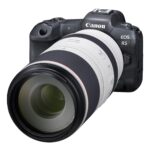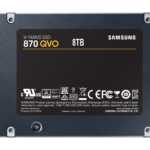If your favourite part about Minecraft is fighting mobs, exploring dungeons and picking up loot, rather than mining, building and crafting, then Minecraft Dungeons will be the game for you.
It is a dungeon crawler role-playing game (RPG) similar in terms of gameplay to the Diablo and Torchlight series of games but in a much more simplified format.
I reviewed Minecraft Dungeons provided by Microsoft on my Windows PC. You don’t need the original Minecraft to play as Minecraft Dungeons is a standalone title completely separate from Minecraft. Minecraft Dungeons is also available on Nintendo Switch, PlayStation 4 and Xbox One.
Dumbed Down Diablo?
Because of its simplicity, Minecraft Dungeons is great for younger gamers who are just starting out on gaming. Those unacquainted with this genre or casual gamers who just want a light-hearted hack-and-slash dungeon romp without too much to think about will also find it fun.
In Minecraft Dungeons, there are no complex skill trees to ponder upon, no character points to worry about spending on attributes like Strength, Intelligence or Magic, and no professions to tie down your character which you might regret later.
All the powers and skills that your character can have are bound to the gear and artifacts that are equipped. These can be switched out anytime, so there aren’t any choices that will make you commit or regret in the long run.
At the start of the game, you can choose your avatar based purely on looks, although it doesn’t really matter since you cannot really see yourself once you don a suit of armour. So it’s pretty much choose avatar, equip gear and artifacts, then off to kill some mobs!
The story for Minecraft Dungeons is familiar and cliched. An illager – a hostile version of villagers in the Minecraft universe – finds an orb of tremendous power, turns evil, massacres everyone, so you the hero have to stop the evil spreading across the land…you get the drift.
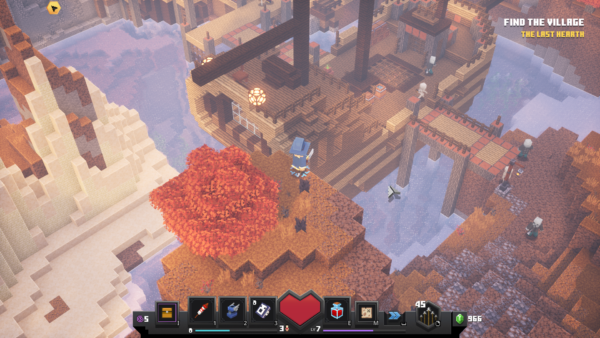
Welcome to the Dungeon
Once a camp is established, which is right after the tutorial, you can select the dungeon to explore on the map and travel there instantly.
Although there are only a limited number of dungeons, you can (and are supposed to) replay them at higher difficulty levels for a chance to encounter different enemies and different loot drops.
And if you are not powerful enough to tackle the next level, playing through previously cleared dungeons at higher difficulties can help you gain XP and arm yourself with better gear and artifacts.
Exploring dungeons is pretty straightforward – just kill everything that moves! There are no NPCs to talk to, no wandering merchants, and no additional quest givers.
There are, however, hordes of enemies and traps aplenty, including an assortment of timed spike traps, crushing blocks and burning lava that you will have to watch out for.
There are also “find the key” type of puzzles but they are made more challenging as the keys tend to escape while you are engrossed in knocking back the hordes. This forces you to chase the keys down again.
One annoyance is the map design – the fixed isometric view angle of the game means that tall structures such as hills and trees will block your view of the map.
Due to this, I have missed out on chests and enemies that are blocked from view. To remedy this, check the map often as chests and dropped items will be highlighted. Bring along a companion pet that can assist you in attacking enemies that you might have missed.
For multiplayer co-op games, you can form a party with up to three other friends either online or couch co-op with the local multiplayer mode.
There is no online matchmaking though, so if you don’t have any friends who are playing Minecraft Dungeons, then you are pretty much on your own.
As cross-platform play isn’t supported at this point in time, only gamers on the same platform can play together, which makes it harder to play with friends who may own the game on other platforms. The developers are working on getting cross-platform play enabled, so that’s something to look forward to.
Enemy Mine
Unsurprisingly, the hostiles in Minecraft Dungeons are familiar faces, including well armoured illagers, marauding zombies, arrow-shooting skeletons, exploding creepers, potion slinging witches, baby zombies on chickens, and many, many more.
While only a few slow moving mobs will attack you in the regular Minecraft Adventure mode, you will now face hordes of hostiles coming at you from all angles at once.
Apart from low-level mobs, you will also face sub-bosses like golems, evokers and the enigmatic endermen. These require some planning and tactics to overcome, which gives the game some challenge.
Evokers are introduced by dramatic music and can cast a multitude of offensive spells, including conjuring snapping jaws beneath your feet that can cause quite a bit of damage and summoning minions that fly around and attack you.
My favourite enemy are the endermen – unlike regular Minecraft where they usually leave you alone, these ones will attack you unprovoked.
You will know when they are nearby – there is a sudden fuzzy and blurry effect like a heatwave accompanied by a low buzzing sound. And since they can teleport all around you, they can be challenging to beat at higher difficulty levels.
Each dungeon has a boss that you have to beat in order to complete the dungeon. Some are quite tough to defeat – if that’s the case, one should seek to level up by replaying some of the earlier quests at a higher difficulty setting to earn better loot and gain more experience.
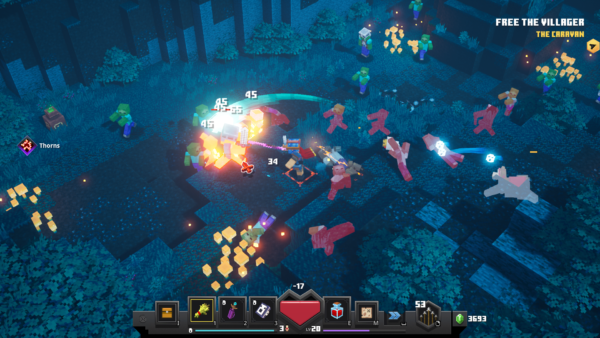
Fortunately, death is not a severe penalty in Minecraft Dungeons compared to games like Diablo. You have three lives per dungeon, and, upon death, you get spawned near the same spot where your character was brought down.
All equipment and inventory items are retained, so there’s no need to rush in and scrabble madly for your precious gear while monsters are still hunting you down.
If all three lives are used up, you will be returned to camp to reflect on your tactics and will have to attempt the dungeon from scratch the next time. There are no “Town Portals” where you can go back to where you left off in the dungeon.
Loot, not so Glorious Loot
In the spirit of keeping things simple, the inventory in Minecraft Dungeons is straightforward. Your character has three slots for gear – one for a melee weapon, another for a suit of armour and the third one for a ranged weapon. That’s it!
There are no slots for helmets, leggings, boots or shields, which makes you even more ill-equipped than in Minecraft.
Apart from gear, your character also has three slots for artifacts. These imbue your characters with different powers that can be activated but will need some cooldown time before being used again.
Examples of artifacts include totems for casting a healing circle for you and your party, wheat for summoning a pet llama, and a tome that uses souls harvested from slain enemies to create a blast radius that knock your enemies back – a real lifesaver when you are so tightly surrounded you can barely move.
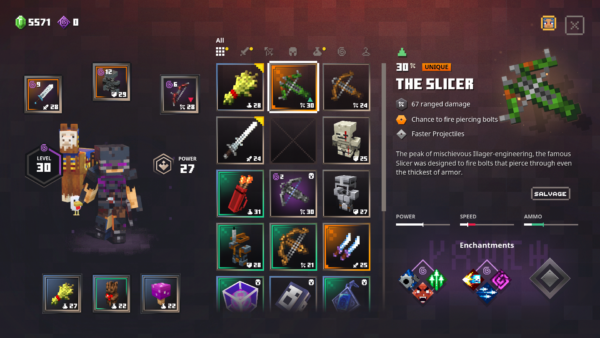
There is no inventory for potions, so all pickups and potions are activated instantly, which typically runs out by the time you run to someplace where you actually need its effects, so it’s pretty pointless picking them up.
What I find is the most challenging aspect of the game is you only have one healing potion that gives you maximum health but it has a cooldown time to refill before you can drink it again.
Unlike conventional dungeon crawlers, you cannot simply stock up on high level health potions and chug them non-stop during a boss fight. Running away and waiting for the health potion fill up is a constant manoeuvre, which becomes a real chore during lengthy boss battles.
There are some artifacts and enchantments that can help in providing more health regeneration options, but with limited artifact slots, it really forces you to evaluate and prioritise what you need to take into certain battles.
Loot drops are fixed for each dungeon, and the game already lays out what kind of loot you can expect before you start in the dungeon.
Common items that are dropped by slain enemies include emeralds for trading with merchants at camp, souls for activating certain artifacts and consumables like food and arrows.
Occasionally, you can pick up a block of TNT that you can carry on your head, and even stack up a few until you meet a nice big horde of enemies to toss at.
Unfortunately, you cannot shoot with your ranged weapon until you toss the TNT blocks, so it wasn’t really useful to me as I didn’t want to be carrying the TNT long distance while sacrificing the use of the ranged weapon.
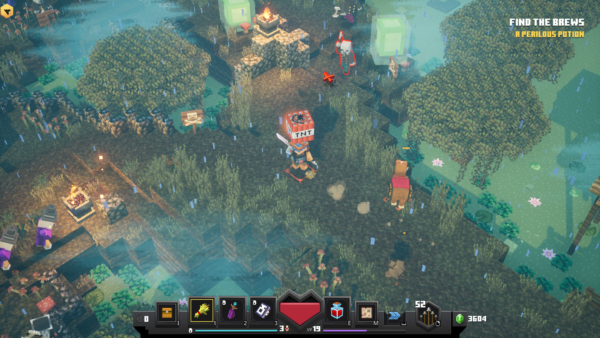
For weapon stats, it’s all about balance – speed, power and reach for melee weapons, and power, speed and ammo for ranged weapons.
Arrows are quite limited, and depending on the weapon you pick, the mileage of the quantity of arrows in your possession also differs.
A more efficient bow, for instance, can use 50 per cent fewer arrows than, say, a hard-hitting heavy crossbow. And to simplify things further, ammunition for projectile weapons are “one type fits all”, and can be used interchangeably on bows or crossbows.
Each piece of weapon and armour will have one or more enchantments that you can invest on using enchantment points, which are obtained every time you level up.
Once you have committed to the enchantment, you can invest more on it with more skill points and this will increase the powers to the various enchantments inherent in the gear.
For instance, with the “Thorns” enchantment, I can add enchantment points to the maximum third tier that will reflect 50 per cent of the damage inflicted on me back to the attacker.
If you want to switch to better gear and enchant the new gear instead, you can retrieve your invested enchantments points when you salvage your old enchanted gear.
As you play the dungeons in higher difficulty settings, you can expect better loot with more enhancements, as well as more powerful artifacts that can deal more damage, harvest more souls or have a shorter cooldown time between uses.
In terms of bling, Minecraft Dungeon’s loots have very little to offer. There are different classifications of loot rarity, but with marginal differentiators in power, stats and aesthetics.
I have found rare gear with poorer stats than an equivalent common one, so finding rare loot just doesn’t offer the same satisfaction as in other dungeon crawler games.
In Minecraft Dungeons, hoarding and inventory management are unnecessary as potions and health sustaining food are used instantly, and the number of arrows in your quiver also resets once you go back to camp, so there’s no point being stingy with them.
You can salvage any gear or artifacts that you don’t need anytime and anywhere in exchange for emeralds, so you don’t need to run back to camp to dump your loot on the merchants to free up your inventory.
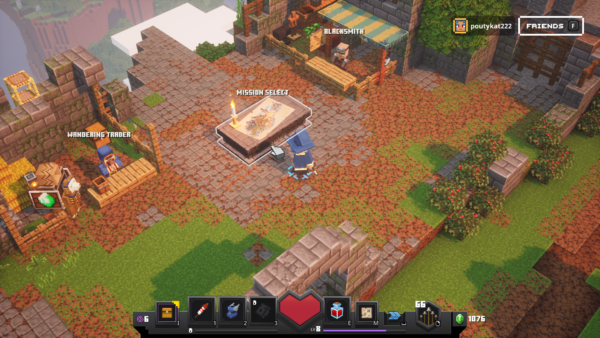
There are two merchants in the camp, but unlike traditional RPGs, you cannot pick and choose what you want to buy. Instead, you pay in emeralds for a random item and hope that it is unique and special.
This applies for both the Blacksmith, who sells weapons and armour, as well as the Wandering Trader who deals in artifacts.
Sad to say, I was not very lucky and received mostly common grade items or weapons below my character’s level during the emerald trades. I am not a fan of this concept of gambling away my precious emeralds for useless items.
I would much rather earn and pay a high price for something I really want, so I am saddled with loads of emeralds with no good place to spend them on.
Worse, you cannot trade items with your friends, so even if you manage to get something that might suit your pals better, there is no way to pass it over to them. It would be nice to have some kind of storage chest in the camp where you can store excess items or save it for another character.
More than Meets the Eye
Minecraft Dungeons rewards the curious adventurer with secret dungeons and plenty of surprises at camp, with random chests to find, newly accessible areas and new decorations at home.
Yes, as a hero, you have a house with a cosy fireplace and pig pens that will show progressively more mementos and trophies as you complete more quests, such as a Redstone Golem head, a standing structure of a creeper and artwork adorning your walls. This is quite a charming concept for a Minecraft fan, and is worth a visit every time just to admire your trophies.
Although Minecraft Dungeons has a limited number of dungeons to explore, there are secret dungeons to be unlocked by maps which spawn by chance.
This will entice gamers to play through all the dungeons a few times for a chance to unlock the secret dungeons, but the thrill diminishes as you are treated with more of the same.
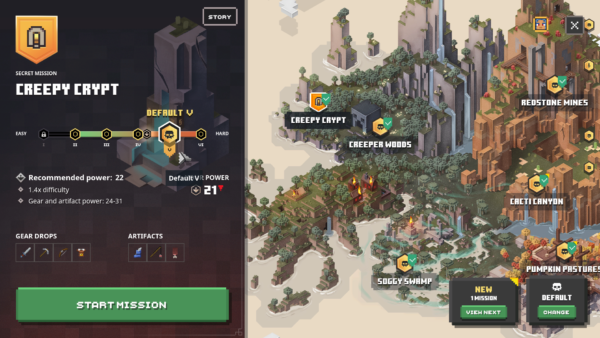
TL;DR
Minecraft Dungeons is a casual dungeon crawler for gamers who just want the action and the simple pleasures of hacking and slashing, without the tedium of inventory management, crafting and character or class development.
Despite the simplicity and limited inventory, it does require some tactics to beat some of the more challenging mobs in the game.
However, the limited number of dungeons gets repetitive since you have to play through the same maps several times in hope of finding secrets, getting better loot drops or levelling up.
The greatest appeal is for fans of Minecraft who enjoy the mobs and elements of Minecraft, but not for micromanagers, serious RPG fans, nor for those hoping to collect drool worthy loot or looking for an engaging story.
Initially, it was fun to see the different Minecraft architecture in each dungeon but that wears off when I had to go through the same dungeon four or five times.
Minecraft Dungeons is available for Windows 10 at the Microsoft Store at S$29.25 here, as well as for Xbox One, PlayStation 4 and Nintendo Switch. The latest DLC, Jungle Awakens, has just been released within weeks of Minecraft Dungeons’ launch, and can be purchased separately at S$8.70 here.
The Hero Edition at S$43.50 also includes access to two DLC packs as well as cosmetic items like additional characters skins, a cape and a companion chicken that is purely decorative and doesn’t do squawk.
